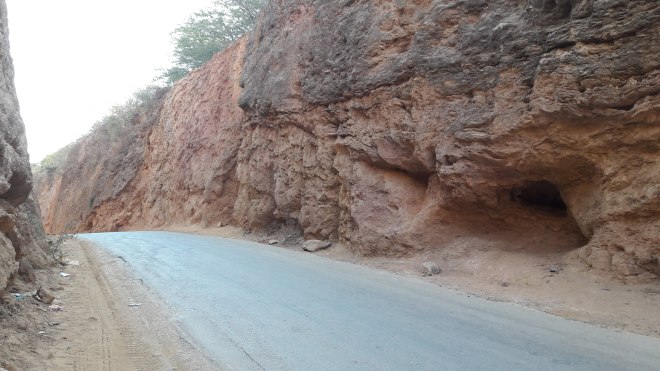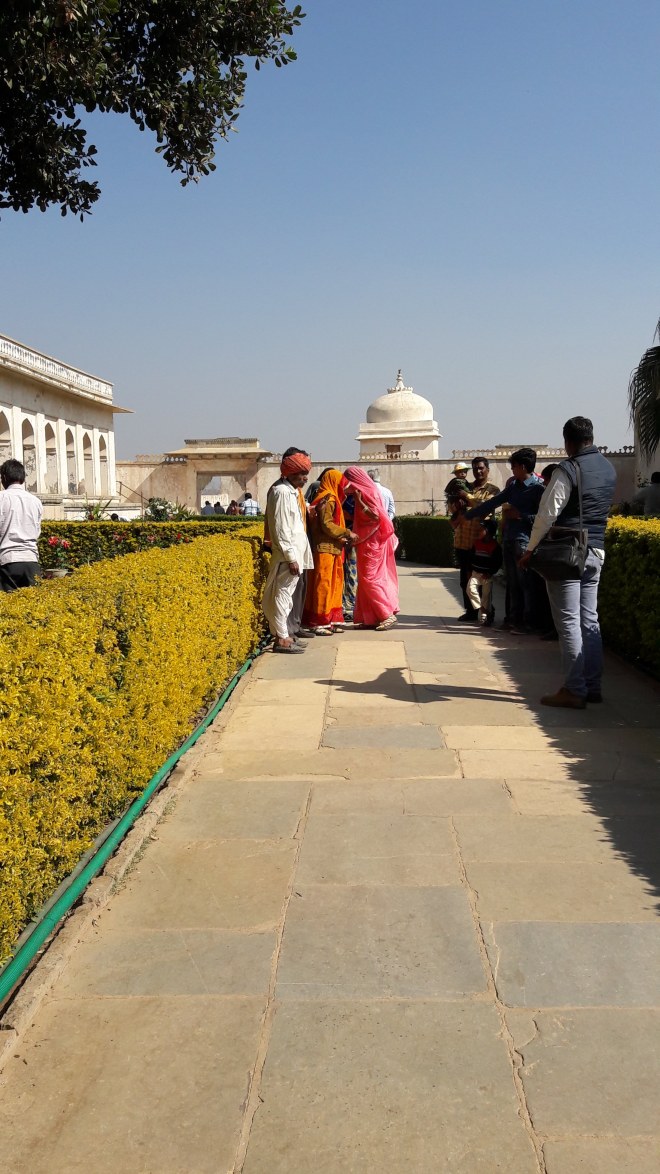After a really long time it’s time for Cee’s Which Way challenge. As I mentioned I had visited Udaipur with the explicit purpose of replenishing my dwindling photo archives 😛
Oh well anyway here are some glimpses from this historic seat of Rajput pride and honor Maharana Pratap Singh who refused to bow to the mighty Mughal emperor, Akbar despite all odds and the famous Haldighati battle (fought on 18 June 1576) with over a thousand casualties. It is interesting that the local guides and Wikipedia reiterate what I have suspected.
Haldighati is often claimed to have been a battle for Rajput or even Hindu honour against the Muslim Mughals. However, interestingly Akbar’s commander-in-chief was Man Singh I of Amber, another Hindu and Rajput to boot. On the other side, Maharana Pratap’s army was also served by Hakim Khan Sur’s Muslim Afghans, and hence any arguments concerning religious conflict have little credence. And quoting from Wikipedia “Honor was certainly involved. But it was the honor of Maharana Pratap at stake, not Rajput or Hindu honor.”
But enough of history (never a favorite subject) and let’s go touring!
 This is the famous Haldighati pass that we all read about in school. Ghati all along I thought meant a valley but actually (in the local language) it means a pass or a narrow neck. This was the only way for the Mughals to pass over to the other side where the Rajput army was ready and waiting to cut down the single file entry of one person at a time. It was only when they used explosives to blow up the mountain were they able to pass through successfully and go on to win the battle and then lose to Maharana Pratap at the Battle of Dewar. Oh well that’s how it is usually with battles isn’t it? Win some lose some. And another interesting bit before I leave – Haldi (or turmeric) is the color of its rocks which, when crushed, produced a bright yellow sand. And hence the name Yellow pass.
This is the famous Haldighati pass that we all read about in school. Ghati all along I thought meant a valley but actually (in the local language) it means a pass or a narrow neck. This was the only way for the Mughals to pass over to the other side where the Rajput army was ready and waiting to cut down the single file entry of one person at a time. It was only when they used explosives to blow up the mountain were they able to pass through successfully and go on to win the battle and then lose to Maharana Pratap at the Battle of Dewar. Oh well that’s how it is usually with battles isn’t it? Win some lose some. And another interesting bit before I leave – Haldi (or turmeric) is the color of its rocks which, when crushed, produced a bright yellow sand. And hence the name Yellow pass.

The view of the entry to the Maharana Pratap’s memorial. And if you can see in the distance a horse, that’s Chetak, Maharana Pratap’s famous, and equally brave and revered battle companion. He is believed to have saved his master’s life and jumped over an elephant and a wide gorge at the cost of his own life.
 That’s the way to the Memorial of the brave and upright warrior Maharana Pratap still much loved and held in high esteem.
That’s the way to the Memorial of the brave and upright warrior Maharana Pratap still much loved and held in high esteem.
 Can you see the way? But actually I wanted to show you this because as a child I imagined the battlefield of Haldighati to be something like this rather than that in the first photo 😀
Can you see the way? But actually I wanted to show you this because as a child I imagined the battlefield of Haldighati to be something like this rather than that in the first photo 😀
 Time to move on to a real fort – the Chittor fort or the Chittorgarh one of India’s largest forts. It sprawls over a hill 180 m (590.6 ft) in height spread over an area of 280 ha (691.9 acres) above the plains of the valley drained by the Berach River. The fort precinct has several historical palaces, gates, temples and two prominent commemorative towers. Some of these pictures I have shared in my earlier posts. The fort was built in the 7th Century it was the stronghold of Rajputs. From 13th century onwards several attacks were made on the fort including that by the Turk king Allaudin Khilji, Bahadur Shah and Akbar. And each time the defenders lost and their wives committed jauhar or burnt themselves in a pyre to avoid being captured. Yes, this fort is of Padmaavat fame and I visited the jauhar kund as well but didnt feel inspired enough to take a picture. This particular section of the fort is in ruins.
Time to move on to a real fort – the Chittor fort or the Chittorgarh one of India’s largest forts. It sprawls over a hill 180 m (590.6 ft) in height spread over an area of 280 ha (691.9 acres) above the plains of the valley drained by the Berach River. The fort precinct has several historical palaces, gates, temples and two prominent commemorative towers. Some of these pictures I have shared in my earlier posts. The fort was built in the 7th Century it was the stronghold of Rajputs. From 13th century onwards several attacks were made on the fort including that by the Turk king Allaudin Khilji, Bahadur Shah and Akbar. And each time the defenders lost and their wives committed jauhar or burnt themselves in a pyre to avoid being captured. Yes, this fort is of Padmaavat fame and I visited the jauhar kund as well but didnt feel inspired enough to take a picture. This particular section of the fort is in ruins.
 But at some places, I liked the placement of the stairs.
But at some places, I liked the placement of the stairs.
 Stairway at Meerabai’s palace. Yes she too lived here married to Bhojraj, the son of Rana Sangha the powerful king of Mewar. But her devotion to Lord Krishna led to her being banished to the servant section.
Stairway at Meerabai’s palace. Yes she too lived here married to Bhojraj, the son of Rana Sangha the powerful king of Mewar. But her devotion to Lord Krishna led to her being banished to the servant section.
 Fascinating isn’t it? I wonder how they climbed these stairs or was there some other structure beside it?
Fascinating isn’t it? I wonder how they climbed these stairs or was there some other structure beside it?
 The Vijay Stambh or the victory tower at another section of the Chittor fort. It was built in in 1448 by Rana Kumbha to commemorate his victory over Mahmud Khilji. So they did win some battles! This tower is dedicated to Lord Vishnu yet the topmost storey features a Jain Goddess Padmavati while the word Allah is inscribed nine times in the third storey and eight times in the eighth. Where are all those people, those days, those philosophies?
The Vijay Stambh or the victory tower at another section of the Chittor fort. It was built in in 1448 by Rana Kumbha to commemorate his victory over Mahmud Khilji. So they did win some battles! This tower is dedicated to Lord Vishnu yet the topmost storey features a Jain Goddess Padmavati while the word Allah is inscribed nine times in the third storey and eight times in the eighth. Where are all those people, those days, those philosophies?
 I couldn’t have a Cee’s which way challenge without a witch tree could I? 😀
I couldn’t have a Cee’s which way challenge without a witch tree could I? 😀
 And finally at Rani Padmini’s Summer Palace. This is one of my prized photos of how despite deeply ingrained traditions Indians effortlessly adopt modern technology regardless and oblivious to any conflict or what the moment. Did you get my point? Raise your hands before I elaborate. Sure? Got it? No?
And finally at Rani Padmini’s Summer Palace. This is one of my prized photos of how despite deeply ingrained traditions Indians effortlessly adopt modern technology regardless and oblivious to any conflict or what the moment. Did you get my point? Raise your hands before I elaborate. Sure? Got it? No?
On the near right is the photographer hired to click a group photograph of the visitors more than half of whom are completely veiled. I left them herding them into position and urging them to at least shift the ghunghat (veil) a bit, muttering in a long suffering tone: how will you know who’s who?
Thank you for visiting and a special thank you to Cee for inspiring me, freeing me and letting me get away with it 😀
Great photos. Thank you for sharing them.
LikeLiked by 1 person
My pleasure. Thanks for visiting
LikeLiked by 1 person
Wonderful write up and amazing pics!
LikeLiked by 1 person
Thanks Vasu 🙂
LikeLike
Great photos. The stone fort is amazing. It would be fun to visit 🙂
LikeLiked by 1 person
Thanks – it was lovely.
LikeLike
Excellent photos for this week. 😀
LikeLiked by 1 person
Thanks a lot Cee 🙂
LikeLike
Wow, what a grand tour we have got. Great pictures Dahlia.
LikeLiked by 1 person
Thanks Rupali, glad you liked 🙂
LikeLike
Loved them D 🙂
LikeLiked by 1 person
Thanks BB 🙂
LikeLiked by 1 person